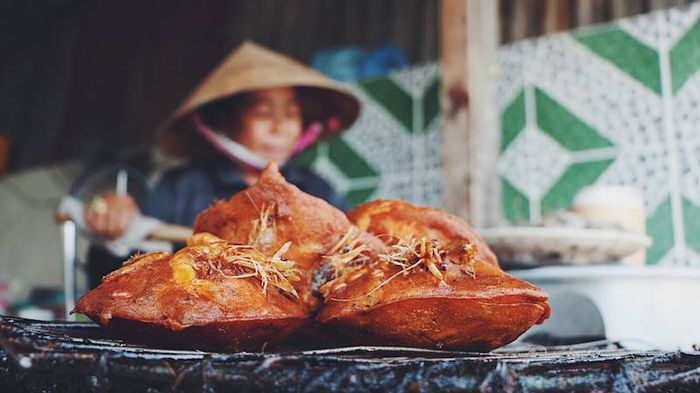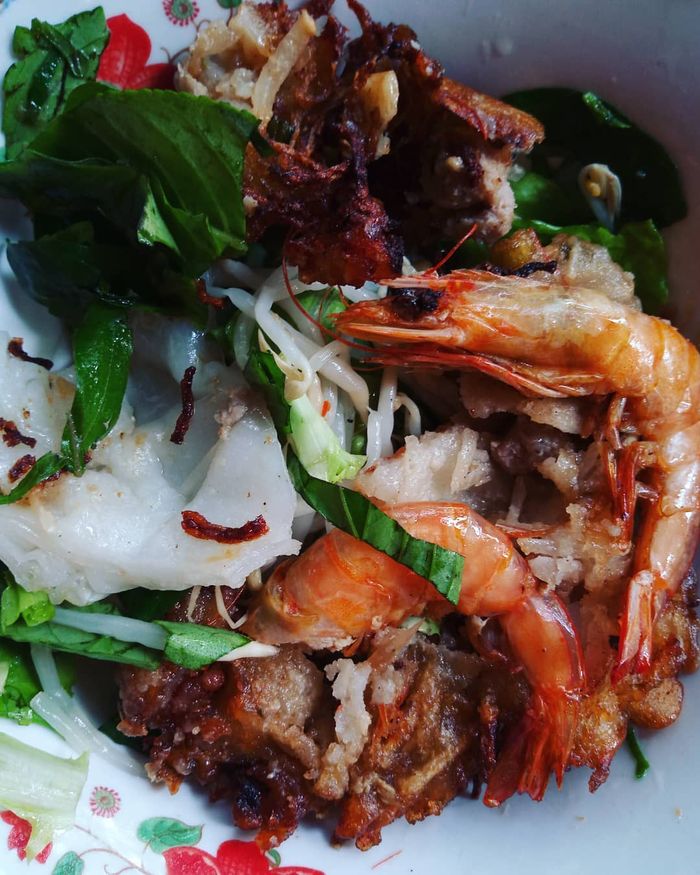If you are wondering what to eat in the list of Tien Giang specialties, banh mi is a great choice. The ingredients for the cake are very simple and familiar such as rice flour, tapioca flour, green beans, lean pork, ground shrimp, straw mushrooms, pork brain, bean sprouts, etc.

Tien Giang patch cake is delicious and crispy
After the ingredients are preliminarily processed and a thick mixture of tapioca and rice flour is obtained, the chef will begin to fry the cakes. The shepherd must be very skillful so as not to break the bread. The cake when ripe has a beautiful golden color. The cake is shaped like a West Lake shrimp cake, with a red shrimp au bending over it. This is a dish that joins the list of specialties in it.

Close-up of delicious patch cake. @huynhtomytom
Banh mi must be eaten when it is hot to feel the crispy taste in each piece of cake. Served with vermicelli, raw vegetables, cucumber and chili garlic fish sauce. When eating, arrange the cake on each piece of raw vegetables, then add cucumber and vermicelli, then dip it in chili garlic fish sauce and enjoy. Looking at the red and green color mixed with the dipping sauce, just thinking about it is really looking forward to the experience.
- Address : Co Muoi cake, Highway 50, Vinh Binh town, Go Cong Tay, Tien Giang province.
- Price : 15,000 VND – 20,000 VND.
Source: Collected internet.
Vietnam is a country on an S-shaped strip of land, located in the center of Southeast Asia, in the east of the Indochina peninsula, to the north by China, to the west by Laos and Cambodia, and to the southeast overlooking the sea. East and Pacific. Vietnam's coastline is 3,260 km long, and its land border is 4,510 km long. On land, from the northernmost point to the southernmost point (as the crow flies) is 1,650km long, from the easternmost point to the westernmost point the widest place is 600km (Northern region), 400km (Southern region), the narrowest place is 50km (Quang Binh).
Festivals are one of the special features in Vietnamese culture. The diversity of ethnic religions makes Vietnam one of the countries with many festivals. Festivals are held to commemorate cultural events. Community spirit is the essence of every festival. There are two parts to festivals: ceremony and festival. The ceremony is to express respect for divinity and people's dreams of health, wealth, luck and happiness for themselves and their loved ones. Festivals are unique features of culture, community, religion, etc. The two biggest traditional festivals are Lunar New Year and Hung King's Death Anniversary. During Lunar New Year, each region has other festivals to celebrate such as Lim Festival in Bac Ninh province, Giong Festival in Soc Son, Perfume Pagoda Festival in Hanoi. Hung King's death anniversary is held every year from the 8th to the 11th of the third lunar month. It is organized so that everyone remembers their roots. With many landscapes recognized by UNESCO as world natural heritage and a wealth of unique regional cultural spaces, Vietnam is a legendary land and also a storehouse of attractive material for filmmakers to exploit. long lasting waterfall.
Vietnam, whose national name is the Socialist Republic of Vietnam, is a socialist country located at the eastern tip of the Indochina peninsula in Southeast Asia, bordering Laos, Cambodia, China, and the sea. East and Gulf of Thailand. The territory of Vietnam has been inhabited since the Paleolithic era, starting with the states of Van Lang and Au Lac. Au Lac was annexed by the Trieu Dynasty in the North in the early 2nd century BC, followed by a period of Northern domination lasting more than a millennium. The independent monarchy was re-established after Ngo Quyen's victory over the Southern Han dynasty. This event paved the way for independent dynasties to succeed and then repeatedly win against wars of invasion from the North as well as gradually expanding to the south. The final period of Northern domination ended after the Lam Son insurgent army's victory over the Ming Dynasty.
Vietnam's terrain has about 40% mountains and forests, 40% hills and coverage of about 75% of the country's area. There are mountain ranges and plateaus such as Hoang Lien Son range, Son La plateau in the north, Bach Ma range and plateaus following the Truong Son range in the south. Network of rivers and lakes in the delta or mountainous areas of the North and Central Highlands. The delta accounts for about 1/4 of the area, including deltas such as the Red River Delta, Mekong River Delta and the Central Coastal Plains, which are densely populated areas. Cultivated land accounts for 17% of Vietnam's total land area.